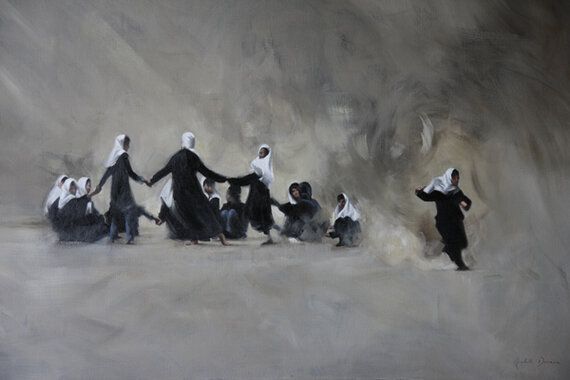Acclaimed war artist Arabella Dorman has visited Afghanistan on several occasions over the past five years in order to capture in her paintings the human face of the conflict there, of both Afghan civilians and of the British forces.
After three decades of continuous war, from the Russian occupation through a brutal civil war, the repressive years of the Taliban and the insurgency that has followed their ousting, the country has taken a heavy toll both physically and mentally.
The exhibition's title, Before the Dawn, alludes to the new era of change and uncertainty now that the Afghan army has been left to fend for itself following the withdrawal of Western forces. It also signals the hopes and fears of each new day.

In the Triptych, Struggle to Survive (above), the canvas has been split between the hands of the despairing man in that his whole life has been wrought with fear and conflict. While the painting hints at elements of universal suffering, one's eyes are drawn to the defiant gaze of the sick but resilient Afghan child, surrounded as she is by the tenderness of the father and the close community ties embodied by the other figures.
"I've never in my experience of travel seen so many children with that thousand mile stare, with eyes that look straight through you, and it breaks your heart," Dorman, 49 from London, tells me. "As a mother myself, it destroys me. Yet within that thousand mile stare is that incredible sense of resilience".
Almost half of Afghanistan's population are below the age of 14. Dorman has found that making quick initial sketches of her subjects in charcoal is an ice-breaker.
"Within 15 minutes you start drawing what you see in someone's eyes. It's fairly distressing. The men have often killed many many people and have seen things no human should ever have to see...yet they are also kind and hospitable and they are poet warriors. When they see me drawing they break into verse about the traumas of their country and people and their determination to rise up from the ashes."

The psychological and physical scars of British troops are captured on canvas in a way seldom seen in the British media. Waiting for First Light (above) was drawn during the bitter conflict in Sangin in Helmand province in the summer of 2009. The troops are waiting to enter enemy territory. Dorman has focused on their apprehension, the last cigarette, remembering their best mate who'd been killed here the day before, thoughts of their families back home as well as the task ahead. It has a timeless quality - it could just as easily have been the trenches of World War I.
There are pictures too that deal with those 453 British soldiers who didn't make it and the terrible effects of post traumatic stress disorder on those who have survived but whose physical and psychological scars will forever link them with Afghanistan. Dorman searches for what those glimpses of human nature can teach us about loss, guilt, grieving as well as heroism and hope.

For the exhibition is not all doom and gloom. Shoulder to Shoulder (above) depicts Afghans and British troops playing football. The painting was inspired by the death of a British captain who was killed by an Afghan soldier during a football training session - a so-called green on blue attack.
"It showed a renewed trust in the human spirit, and how the courage to trust the Afghans again after such a devastating low hand attack triumphs violence and deceit."
Despite the ordeal of Afghanistan's children and their families, life has improved for many. Infrastructural advances, further educational and business opportunities have all made life a little easier for the ordinary Afghan. The big question is whether this state of affairs is sustainable without the physical support of Western forces. The fact that 2,000 Afghan army soldiers have been killed in this year alone does not augur well.

The Dance (above) encapsulates many of these improvements. Under the Taliban, girls were not allowed to attend school and music was banned. Yet here are a group of girls dancing in their national school uniform while storm clouds gather above them.
"I felt this was incredibly symbolic. I didn't however put it into a context or location because what struck me so much was this was a universal language. Human beings have danced since time immemorial. It's a primeval instinct within us all. It reveals that that which unites us is stronger than that which divides us."
Before the Dawn asks the viewer to engage more deeply with the Afghan conflict - with the impact on those that fought and those caught up in it. It is concerned with larger issues too - comradeship, hardship, courage, vulnerability and hope.
The exhibition runs from 4 - 15 November at La Galleria Pall Mall, 30 Royal Opera Arcade, London SW1Y 4UY. A series of talks by guests such as journalists Jon Snow and Christina Lamb, and Generals Lord Richards of Herstmonceaux and Sir Nicholas Parker will take place throughout the exhibition.
Ticket sales and 10% of sales of work will go to Afghanaid and Walking With the Wounded.
The images here are used with the permission of the artist.